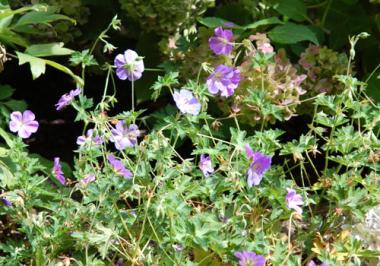My first stop was Nonotuck Street. On a gorgeous sunny afternoon, I got a sneak peek at some of the gardens and studios in the upcoming self-guided Northampton Center for the Arts Third Annual Artists' Studio and Garden Tour.
First up was the pottery studio and Japanese-flavored garden of artist Chuck Stern. While the studio was in a decidedly advanced form of disarray, it was brimming with eclectic pieces of pottery that were soda-fired—a type of firing that employs soda ash mixed in water—in the propane-driven kiln in Stern's garden. To get an up-close look at the greenery, it's necessary to mount steps in a rock wall, then follow a path of stones strategically placed to lead to the kiln and the adjacent courtyard. The brick kiln is covered with a metal awning, enabling Stern to work outside even in inclement weather. The courtyard houses a picnic table where Stern and his wife often eat, and rough stone benches that look like a mini-Stonehenge. The space is bordered with two majestic Japanese maple trees Stern planted 26 years ago. One of them, unfortunately, is slowly dying.
"Once they withstand any sort of injury, that's kind of it for them. So I planted this dogwood maple to grow up next to it to replace it when it's gone," said Stern as he pointed out the two trees.
While Stern's garden has bursts of colorful flowers, the dominating foliage consists of different types of variegated Japanese grasses, blanketing the yard in shades of green from hunter to neon. Stern usually plants these grasses and then lets them roam where they like. "Most of my plants are pretty aggressive," said Stern. "I like to plant them and let them battle it out."
Next, I headed up Route 66 to Florence Road. Although Mapquest failed me yet again, I eventually found the four-year-old gardens of artist Shawn Farley. After offering me bug spray (and assuring me I'd want it when we headed through the woods), Farley began the tour in her herb garden. Farley pointed out lavender, tarragon, rosemary, sage, thyme, oregano and mint. Across the walkway was a shade garden boasting fallopia, lamium, oakleaf hydrangea and a hand-crafted wooden bench.
A large butterfly bush with vibrant purple flowers caught my eye after we passed through a gate into the back yard. In certain parts of the year, Farley informed me, the bush is swarming with lepidopteran visitors. In the center of the yard is a brick dais with another bench and corrugated metal chairs, surrounded by leafy ferns and shrubs as well as vibrant blooms.
Farley next took me into the woods behind her house. What I saw amongst the trees instantly reminded me of The Blair Witch Project. Sticks and stones were purposefully arranged, but in a subtle way: you had to look with a keen eye to discern if many of the structures were naturally occurring or deliberate. On some, baubles hung, swaying and tinkling in the faint breeze. In keeping with her specific genre of art—she makes sculptures with found objects—Farley tries to incorporate much of the natural landscape into her garden arrangements, making use of fallen branches, rocks covered in moss, rotting stumps.
"I just try to work [these things] into the landscape," said Farley. Although she has some plants of a more delicate nature—hosta, woodland poppies, dicentra, pachysandra—in her woodland garden, Farley doesn't worry about their durability as people traipse around the groomed forest.
"The idea is to try and create paths for people to walk on, but if you step on it, that's all right," said Farley. "It's the woods. It can't be too precious. It's got to take care of itself."
Because Farley's studio isn't at her house, she's bringing many of her slightly demon-like sculptures home for the tour, mounting them on trees in the woodland garden.
The next morning, I headed back to Nonotuck Street to the home of Betsy Stone with photographer/gardener Sam West. The painter lives directly behind Stern—they installed a door in the fence separating their properties so garden tour participants can easily get from one garden to the other. After treating us to cucumber- and lime-infused artisanal water, Stone showed us her gardening journal.
"I like to keep track of plants that I like and their progress," said Stone. "I think gardening is about the fantasy of what it's going to look like."
We followed Stone outside. Stacks of firewood lined the spacious backyard. A battered wooden love seat and chairs sat in the corner, and a hammock swung between two trees at the far edge of the yard. The garden proper features a wide range of plants like aster, turtlehead, black negligee—"The name is part of the reason why I bought it," said Stone—hydrangeas and geraniums. Catalpa trees provide plenty of shade in the garden while invasive Norway maples are in abundance on the edge of the property. Stone has been attempting to eradicate the Norways by removing them and planting other greenery in their places.
"I'm having a battle with them," Stone said.
The artist's immaculate studio is inside, on the second floor of her spacious home. Primarily a portrait painter, Stone has a work-in-progress of a neighboring teenage girl on display as well as finished pieces culled from past projects.
During the tour on September 7, Stern, Farley, Stone, Robin Freedenfeld, Nancy Goldstein, Jim Hankins and Nanny Vonnegut will be on hand to answer questions about their artwork and gardens. Upon registering, participants receive a map of the locations, including the garden of University Gallery curator Eva Fierst, where people can join Center for the Arts director Penny Burke for refreshments."
Sept. 7, 1-5 p.m. $15/advance, $20/door. Call the Center for the Arts at (413) 584-7327 to reserve tickets or purchase them in person at the Center, State Street Fruit Store or Cooper's Corner.



